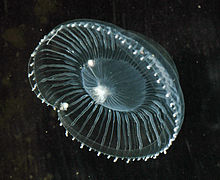Leptomedusae
| Thecate hydroids | |
|---|---|
 |
|
| Crystal Jelly (Aequorea victoria, Conica: Aequoreidae) with the parasitic amphipod Hyperia medusarum | |
| Scientific classification | |
| Kingdom: | Animalia |
| Phylum: | Cnidaria |
| Class: | Hydrozoa |
| Subclass: | Leptolinae |
| Order: |
Leptomedusae Haeckel, 1879 |
| Suborders | |
|
Conica |
|
| Synonyms | |
|
Leptomedusa Haeckel, 1879 |
|
Conica
Proboscidoidea
and see text
Leptomedusa Haeckel, 1879
Leptothecata Cornelius, 1992
Leptothecatae Cornelius, 1992
Thecaphora Hincks, 1868
Thecaphorae Hincks, 1868
Thecata Fleming, 1828
Thecatae Fleming, 1828
Leptomedusae or Leptomedusa, commonly called thecate hydroids, are a cnidarian order in the subclass Leptolinae. They were formerly placed at suborder rank in the paraphyletic "Hydroida". Their closest living relatives, according to the modern view, are the Anthomedusae which are similar enough to have always been considered closely related, and the very apomorphic Siphonophora which were placed outside the "Hydroida". Given that there are no firm rules for synonymy for high-ranked taxa, alternative names like Leptothecata, Thecaphora or Thecata, with or without the ending emended to "-ae", are also often used for the Leptomedusae. World Hydrozoan Database currently uses the name Leptothecata.
The about 1,900 species of Leptomedusae are characterized by a number of features: Their polyps are always living in colonies with the hydranths set in hydrotheca which are usually permanent and often long enough so the animal can fully retract into it; some have very reduced hydrothecae resembling Anthomedusae. There is a single whorl of tentacles.
...
Wikipedia
